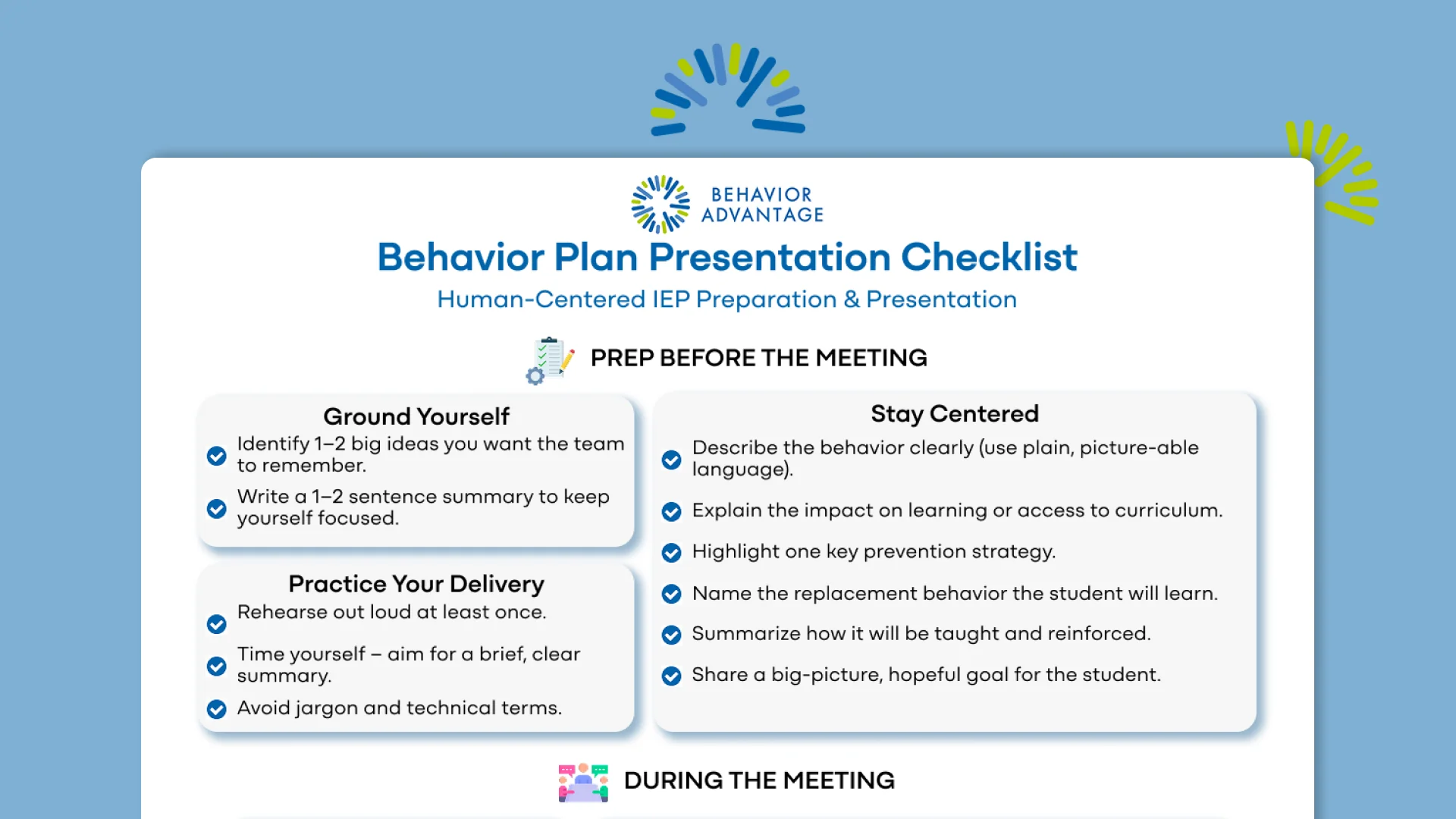When it comes to behavior intervention, the stakes are high — not just for the student, but for everyone involved. Presenting a Functional Behavior Assessment (FBA) and Behavior Intervention Plan (BIP) during an Individualized Education Program (IEP) meeting requires much more than simply reading a document aloud. It calls for preparation, empathy, and a strong commitment to making the information clear, accessible, and actionable for the entire team.
Behavior is Complex — and Emotional
First, let’s recognize an important truth: behavior is complicated. Even among experts, there’s still healthy debate and learning. Most people attending an IEP meeting haven’t spent years studying behavior theory, and that’s okay. What matters is that we create an environment where everyone can understand the plan and feel empowered to support the student.
It’s also important to acknowledge the emotions in the room. Caregivers might feel sadness, guilt, or frustration when discussing their child’s behavior. Teachers may feel overwhelmed or even underprepared to address challenging behavior in their classrooms. Every person comes into the IEP process carrying their own experiences and emotions. By keeping this in mind, we stay grounded in the shared goal: improving or increasing skills that will help the student succeed in school and beyond.
Download our free Behavior Plan Presentation Checklist

Taking Ownership of Our Role
As providers and team members, we have a responsibility to make sure that the behavior plan is accessible, clear, and concise. It’s not enough to create a well-designed plan — we have to ensure that the team understands it and feels capable of implementing it. This starts with how we present the information during the meeting.
Accessible means using plain language — not drowning the team in jargon, acronyms, or technical vocabulary. Ethical practice demands that we communicate clearly, not show off our expertise.
Clear means transparent communication. If the team is expected to agree to the plan, they must understand the key points.
Concise means keeping it short and purposeful. An IEP meeting is not the time for an in-depth behavior training or a page-by-page read-aloud. Your goal is to give a strong overview that invites later training and support, not to overwhelm the team in one sitting.
Preparation: Getting Clear on the Big Ideas
Before you even step into the meeting, take a few minutes to ground yourself in the “big ideas” of the plan. Ask yourself: If the team only remembers one or two things, what should they be? Write down a quick summary for yourself — it will serve as your anchor throughout the discussion.
From there, build a simple outline:
- Describe the behavior simply: Use clear, easy-to-picture language. (“John leaves the carpet during group learning and goes to play with toys.”)
- Explain the impact: How often is it happening? How is it affecting the student’s learning or access to the curriculum?
- Highlight one prevention strategy: Share one key proactive approach that will help.
- Name the replacement behavior: What are we teaching the student to do instead of the challenging behavior?
- Summarize the teaching plan: How will we teach, practice, and motivate the new behavior?
- Share the big-picture goal: Give a hopeful, reasonable vision of success. (“If we’re successful, we might see John request a break instead of leaving group time. That would be a huge celebration!”)
By focusing on these big ideas, we’re doing more than just reporting out a behavior plan — we’re showing families and the team that our goal is to support the whole child, not simply to reduce challenges. We are working to build meaningful skills that the student can use not just today, but as they move into the next grade, high school, and eventually into the workplace. When we present behavior intervention through a lens of growth and skill-building, we help families see that a BIP is about creating opportunities for success, not just correcting problems. Most importantly, we show that we genuinely care about their child’s future.
Navigating IEP team dynamics might seem daunting at first, but we have prepared a guide to make it easier for you!
Practice Makes a Difference
Once you have your outline, practice presenting it — out loud. It’s easy to imagine you’ll sound clear in your head, but words can stumble out differently when spoken. Rehearsing aloud (in the car, in the shower, while making coffee) helps you refine your delivery. A little rehearsal can go a long way.
Also, time yourself. Many providers are surprised at how long they talk during meetings. Keeping your presentation tight honors the team’s time — and your own. Only share what’s necessary for the team to understand the big picture, leaving room for deeper training afterward.
Though this preparation may seem like extra work, it saves time and frustration down the road. A well-communicated plan increases the likelihood of faithful implementation — and, ultimately, student success.
Presenting at the Meeting: Staying Centered and Strategic
Start with a strength. Always. Even if strengths have been shared already, offer another one — something genuine you’ve observed. Instead of a superficial comment like “he likes dinosaurs,” focus on a characteristic such as persistence, creativity, humor, or kindness. This connects you to the student and the family, showing that you see and believe in the student’s potential.
Take a deep breath, speak slowly, and follow your outline. Use the BIP document as a reference guide, not a script. For example, you might say, “On page one, we describe the target behavior. On page two, we discuss prevention strategies. Turn to page four, where we outline the replacement behavior we’ll teach.”
As you speak, watch your audience. If you notice confused looks, distraction, or disengagement, it’s a sign to slow down, clarify, or ask a checking question. If you see nodding or steady eye contact, you’re likely on track.
When checking for understanding, avoid asking, “Does that make sense?” Instead, put the responsibility on your delivery: “Am I making sense?” This slight shift shows that you see communication as your responsibility, not a failure on the part of others.
Don’t Forget the Follow-Up
Finally, describe at least one clear plan for follow-up. Implementation support is essential for success. Set up a future check-in, a modeling session, or a time to deliver needed materials. (“I’ll be meeting with John’s teacher this week to provide the visual supports,” or “John and I will meet tomorrow to introduce the new break card.”)
Behavior change doesn’t happen overnight, and neither does full team alignment. A thoughtful, well-prepared presentation, followed by real support, lays the groundwork for both.
Conclusion
Presenting a behavior plan during an IEP meeting isn’t just a technical task — it’s a deeply human one. By preparing carefully, presenting clearly, and staying grounded in empathy, we can move beyond compliance and toward true collaboration.
At the heart of every behavior plan is a student who deserves the best possible support, and a team that can make it happen — with the right tools, the right mindset, and the right connection.
At Behavior Advantage, we have the right tools to help you prepare for any IEP meeting in the best way possible!











